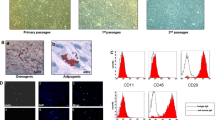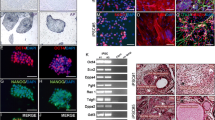Abstract
Diabetes mellitus, which is the result of autoimmune destruction of the insulin-producing β cells, occurs by loss of insulin-secreting capacity. The insufficient source of insulin-producing cells (IPCs) is the major obstacle for using transplantation as diabetes treatment method. The present study suggests a method to form islet-like clusters of IPCs derived from mouse embryonic stem cells (mESCs). This protocol consists of several steps. Before starting this protocol, embryoid bodies (EBs) should be cultured in suspension in conditioned medium of isolated mouse pancreatic islet in combination with activing A to be induced. Then differentiated mESCs were replaced with dishes supplemented with basic fibroblast growth factor (bFGF). Next, bFGF was withdrawn, and cyclopamine and noggin were added. Then the cells were treated with B27, nicotinamide, and islet-conditioned medium for maturation. mESCs, as the control group, were cultured without any treatment. An enhanced expression of pancreatic-specific genes was detected by qRT-PCR and immunofluorescence in the differentiated mESCs. The differentiated mESCsco express other markers of pancreatic islet cells as well as insulin. This method exhibited higher insulin generation and further improvement in IPCs protocol that may result in an unlimited source of ES cells suitable for transplantation. The results indicated that conditioned medium, just as critical components of the stem cell niche associated with other factors, had high potential to differentiate mESCs into IPCs.






Similar content being viewed by others
References
Abu Bakar Sajak, A., Mediani, A., Maulidiani, Ismail, A., & Abas, F. (2017). Metabolite variation in lean and obese streptozotocin (STZ)-induced diabetic rats via (1)H NMR-based metabolomics approach. Applied Biochemistry and Biotechnology, 182(2), 653–668.
Ballas, C. B., Zielske, S. P., & Gerson, S. L. (2002). Adult bone marrow stem cells for cell and gene therapies: implications for greater use. Journal of Cellular Biochemistry. Supplement, 38, 20–28.
Bundhun, P. K., Bhurtu, A., & Yuan, J. (2017). Impact of type 2 diabetes mellitus on the long-term mortality in patients who were treated by coronary artery bypass surgery: a systematic review and meta-analysis. Medicine, 96(22), e7022.
Chang, C., Niu, D., Zhou, H., Li, F., & Gong, F. (2007). Mesenchymal stem cells contribute to insulin-producing cells upon microenvironmental manipulation in vitro. Transplantation Proceedings, 39(10), 3363–3368.
Chen, C. Y., Cheng, Y. Y., Yen, C. Y., & Hsieh, P. C. (2017). Mechanisms of pluripotency maintenance in mouse embryonic stem cells. Cellular and Molecular Life Sciences: CMLS, 74(10), 1805–1817.
D’Amour, K. A., Agulnick, A. D., Eliazer, S., Kelly, O. G., Kroon, E., & Baetge, E. E. (2005). Efficient differentiation of human embryonic stem cells to definitive endoderm. Nature Biotechnology, 23(12), 1534–1541.
D’Amour, K. A., Bang, A. G., Eliazer, S., Kelly, O. G., Agulnick, A. D., Smart, N. G., Moorman, M. A., Kroon, E., Carpenter, M. K., & Baetge, E. E. (2006). Production of pancreatic hormone-expressing endocrine cells from human embryonic stem cells. Nature Biotechnology, 24(11), 1392–1401.
Dave, S. D., Vanikar, A. V., & Trivedi, H. L. (2013). Extrinsic factors promoting in vitro differentiation of insulin-secreting cells from human adipose tissue-derived mesenchymal stem cells. Applied Biochemistry and Biotechnology, 170(4), 962–971.
De Felici, M., Farini, D., & Dolci, S. (2009). In or out stemness: comparing growth factor signalling in mouse embryonic stem cells and primordial germ cells. Current Stem Cell Research & Therapy, 4(2), 87–97.
Ebrahimi-Barough, S., Hoveizi, E., Norouzi Javidan, A., & Ai, J. (2015). Investigating the neuroglial differentiation effect of neuroblastoma conditioned medium in human endometrial stem cells cultured on 3D nanofibrous scaffold. Journal of Biomedical Materials Research. Part A., 103(8), 2621–2627.
Elham, H., Fardin, F., & Mahmod, H. (2017). The roles of the co-culture of mEScs with pancreatic islets and liver stromal cells in the differentiation of definitive endoderm cells. Biologicals: Journal of the International Association of Biological Standardization, 45, 9–14.
Fujitani, Y. (2017). Transcriptional regulation of pancreas development and beta-cell function [review]. Endocrine Journal, 64(5), 477–486.
Golden, S. H., Maruthur, N., Mathioudakis, N., Spanakis, E., Rubin, D., Zilbermint, M., & Hill-Briggs, F. (2017). The case for diabetes population health improvement: evidence-based programming for population outcomes in diabetes. Current Diabetes Reports, 17(7), 51.
Hoveizi, E., Khodadadi, S., Tavakol, S., Karima, O., & Nasiri-Khalili, M. A. (2014). Small molecules differentiate definitive endoderm from human induced pluripotent stem cells on PCL scaffold. Applied Biochemistry and Biotechnology, 173(7), 1727–1736.
Hoveizi, E., Massumi, M., Ebrahimi-barough, S., Tavakol, S., & Ai, J. (2015). Differential effect of Activin A and WNT3a on definitive endoderm differentiation on electrospun nanofibrous PCL scaffold. Cell Biology International, 39(5), 591–599.
Hoveizi, E., Nabiuni, M., Parivar, K., Ai, J. and Massumi, M. (2013) Definitive endoderm differentiation of human-induced pluripotent stem cells using signaling molecules and IDE1 in three-dimensional polymer scaffold. Journal of biomedical materials research. Part A, 102, 4027–36.
Jiang, J., Au, M., Lu, K., Eshpeter, A., Korbutt, G., Fisk, G., & Majumdar, A. S. (2007). Generation of insulin-producing islet-like clusters from human embryonic stem cells. Stem Cells, 25(8), 1940–1953.
Kang, X., Xie, Y., Powell, H. M., James Lee, L., Belury, M. A., Lannutti, J. J., & Kniss, D. A. (2007). Adipogenesis of murine embryonic stem cells in a three-dimensional culture system using electrospun polymer scaffolds. Biomaterials, 28(3), 450–458.
Kroon, E., Martinson, L. A., Kadoya, K., Bang, A. G., Kelly, O. G., Eliazer, S., Young, H., Richardson, M., Smart, N. G., Cunningham, J., Agulnick, A. D., D’Amour, K. A., Carpenter, M. K., & Baetge, E. E. (2008). Pancreatic endoderm derived from human embryonic stem cells generates glucose-responsive insulin-secreting cells in vivo. Nature Biotechnology, 26(4), 443–452.
Lee, J., Han, D. J., & Kim, S. C. (2008). In vitro differentiation of human adipose tissue-derived stem cells into cells with pancreatic phenotype by regenerating pancreas extract. Biochemical and Biophysical Research Communications, 375(4), 547–551.
Lee, S. H., Park, M. H., Park, S. J., Kim, J., Kim, Y. T., Oh, M. C., Jeong, Y., Kim, M., Han, J. S., & Jeon, Y. J. (2012). Bioactive compounds extracted from Ecklonia cava by using enzymatic hydrolysis protects high glucose-induced damage in INS-1 pancreatic beta-cells. Applied Biochemistry and Biotechnology, 167(7), 1973–1985.
Lumelsky, N., Blondel, O., Laeng, P., Velasco, I., Ravin, R., & McKay, R. (2001). Differentiation of embryonic stem cells to insulin-secreting structures similar to pancreatic islets. Science, 292(5520), 1389–1394.
Maehr, R., Chen, S., Snitow, M., Ludwig, T., Yagasaki, L., Goland, R., Leibel, R. L., & Melton, D. A. (2009). Generation of pluripotent stem cells from patients with type 1 diabetes. Proceedings of the National Academy of Sciences of the United States of America, 106(37), 15768–15773.
Massumi, M., Hoveizi, E., Baktash, P., Hooti, A., Ghazizadeh, L., Nadri, S., Pourasgari, F., Hajarizadeh, A., Soleimani, M., Nabiuni, M., & Khorramizadeh, M. R. (2014). Efficient programming of human eye conjunctiva-derived induced pluripotent stem (ECiPS) cells into definitive endoderm-like cells. Experimental Cell Research, 322(1), 51–61.
McLean, A. B., D’Amour, K. A., Jones, K. L., Krishnamoorthy, M., Kulik, M. J., Reynolds, D. M., Sheppard, A. M., Liu, H., Xu, Y., Baetge, E. E., & Dalton, S. (2007). Activin a efficiently specifies definitive endoderm from human embryonic stem cells only when phosphatidylinositol 3-kinase signaling is suppressed. Stem Cells, 25(1), 29–38.
Mfopou, J. K., Chen, B., Mateizel, I., Sermon, K., & Bouwens, L. (2010). Noggin, retinoids, and fibroblast growth factor regulate hepatic or pancreatic fate of human embryonic stem cells. Gastroenterology, 138, 2233–2245 2245 e2231–2214.
Ni, Z., Zhang, Y., Wang, H., Wei, Y., Ma, B., Hao, J., Tu, P., Duan, H., Li, X., Jiang, P., Ma, X., Wang, B., Wu, R., Zhu, J., & Li, M. (2016). Construction of a fusion peptide 5rolGLP-HV and analysis of its therapeutic effect on type 2 diabetes mellitus and thrombosis in mice. Applied Biochemistry and Biotechnology, 179(1), 59–74.
Prince, V. E., Anderson, R. M., & Dalgin, G. (2017). Zebrafish pancreas development and regeneration: fishing for diabetes therapies. Current Topics in Developmental Biology, 124, 235–276.
Shaer, A., Azarpira, N., & Karimi, M. H. (2014). Differentiation of human induced pluripotent stem cells into insulin-like cell clusters with miR-186 and miR-375 by using chemical transfection. Applied Biochemistry and Biotechnology, 174(1), 242–258.
Sherwood, R. I., Jitianu, C., Cleaver, O., Shaywitz, D. A., Lamenzo, J. O., Chen, A. E., Golub, T. R., & Melton, D. A. (2007). Prospective isolation and global gene expression analysis of definitive and visceral endoderm. Developmental Biology, 304(2), 541–555.
Soria, B., Roche, E., Berna, G., Leon-Quinto, T., Reig, J. A., & Martin, F. (2000). Insulin-secreting cells derived from embryonic stem cells normalize glycemia in streptozotocin-induced diabetic mice. Diabetes, 49(2), 157–162.
Spaeth, J. M., Walker, E. M., & Stein, R. (2016). Impact of Pdx1-associated chromatin modifiers on islet beta-cells. Diabetes, Obesity & Metabolism, 18(Suppl 1), 123–127.
Wang, Z., & Huang, J. (2014). Neuregulin-1 increases connexin-40 and connexin-45 expression in embryonic stem cell-derived cardiomyocytes. Applied Biochemistry and Biotechnology, 174(2), 483–493.
Yang, J., Wu, C., Stefanescu, I. and Horowitz, A. (2017) Analysis of Retinoic Acid-induced Neural Differentiation of Mouse Embryonic Stem Cells in Two and Three-dimensional Embryoid Bodies. Journal of visualized experiments, https://doi.org/10.3791/55621.
Zhou, G., Chiu, D., Qin, D., Niu, L., Cai, J., He, L., Huang, W., & Xu, K. (2012). Detection and clinical significance of CD44v6 and integrin-beta1 in pancreatic cancer patients using a triplex real-time RT-PCR assay. Applied Biochemistry and Biotechnology, 167(8), 2257–2268.
Zhu, R., Liu, H., Liu, C., Wang, L., Ma, R., Chen, B., Li, L., Niu, J., Fu, M., Zhang, D. and Gao, S. (2017) Cinnamaldehyde in diabetes: A review of pharmacology, pharmacokinetics and safety. Pharmacological research, 122, 78–89.
Funding
This study was financially supported by the vice chancellor of research affairs of Ahvaz Jondishapur University of Medical Science, Cellular and Molecular Research Center, Grant No: CMRC-9415 and Iranian Stem Cell Network.
Author information
Authors and Affiliations
Corresponding author
Ethics declarations
Conflict of Interest
The authors declare that they have no conflicts of interest.
Rights and permissions
About this article
Cite this article
Elham, H., Mahmoud, H. The Effect of Pancreas Islet-Releasing Factors on the Direction of Embryonic Stem Cells Towards Pdx1 Expressing Cells. Appl Biochem Biotechnol 186, 371–383 (2018). https://doi.org/10.1007/s12010-018-2733-3
Received:
Accepted:
Published:
Issue Date:
DOI: https://doi.org/10.1007/s12010-018-2733-3




